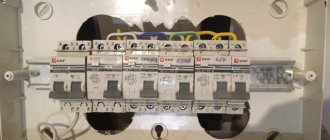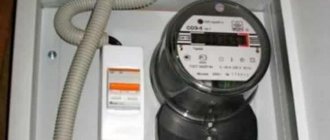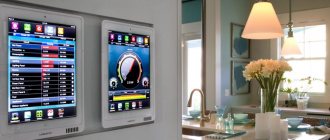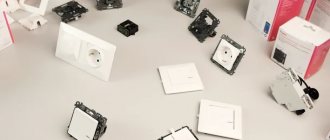Nowadays, smart home systems are becoming increasingly common on trading platforms. Someone knows well what they are and what they are needed for. But most people have only heard about them briefly and have a vague idea of their merits. Meanwhile, these technologies can significantly change the daily life of every home owner. Our review is intended to slightly expand the understanding of this concept for ordinary people and tell us what a smart home is.
What's happened
Smart house - this is how this phrase sounds in English. This is a kind of home automatic complex, which contains almost all household appliances controlled by one system.
This system is not called “smart” for nothing. She has a brain - this is her own personal program, under the guidance of which all devices operate, performing service functions.
And such an electronic “brain” expands the capabilities of a smart home many times over and provides a lot:
- Remote control and monitoring of the entire electrical system and electronic devices located in the house.
- Programming household appliances to suit your preferences (for example, turning on lights and heating devices on a timer).
- Configuring all devices to operate according to a specific scenario. This means - if this happens, then this needs to be done. Well, for example, the sun has risen and the temperature in the room has risen, which means that the air conditioner needs to work. Myself! Automatically!
- Control the same household devices using voice commands.
And this is only a small part of what smart house technology can provide.
For the average user of such systems, there is no need at all to learn the basics of programming. It is enough to determine how all home devices will communicate with the head unit - Bluetooth, Wi-Fi, ZigBee. And the home owner just has to find and install special software on his personal smartphone or tablet and use all the amenities.
As we said at the beginning, this is not a new technology. Many people know or have heard about it. The only thing that stops many is - are these smart home technologies really necessary? Let's add some more benefits to these systems. It also becomes possible to manage:
- Lighting;
- Video surveillance;
- Climate control equipment;
- Household appliances;
- Reasonable energy saving;
- Protection against leaks, gas, fire;
- Global security capabilities;
- The service life of electrical equipment is extended;
- Extremely maximum level of comfort, which is chosen by the users themselves;
- Economical use of all household resources;
- No subscription fee.
Free consultation
We will select the optimal solution for your facility for free and develop a conceptual project with a budget estimate! To clarify the terms of service, please call toll-free 8-800 301 24 45, email: [email protected] or leave your contact and we will contact you. You can also sign up for a free online* video consultation with an INTELVISION specialist at a time convenient for you. *We use free and convenient video conferencing tools such as Zoom and Google Meet that do not require installation of additional software and work directly from the browser.
What does it consist of?
Globally, all smart home systems consist of several elements:
- Central controller or hub. It is he who combines all the elements of a “smart house” into a single complex.
- A program for a smartphone or PC, for example, such as Smart Things, with which you can quickly and easily make the necessary system settings, start or stop various scenarios, turn on or off smart household appliances and lighting.
- Various types of sensors. These little helpers collect information from around the house - temperature, operation of household appliances, security alarms - and send it to the central control device.
- Executive devices. All commands coming from the hub are executed by these actuators. Simply put, these are various types of externally controlled relays that can automatically turn on/off home appliances.
- Smart home appliances. It is clear that an ordinary electric kettle cannot turn on according to a schedule. But there is a whole class of household appliances that can work according to the owner’s commands. For example, a smart refrigerator can track the expiration dates of products, and not only - it also has other interesting functions. This also includes various types of sockets, switches, air conditioners, leakage protection systems, and so on.
Comfort, as we see, is ensured, but this is not the main advantage of smart systems. The main advantage is that they provide a guaranteed opportunity to reduce the risks of larger losses:
- Home Flood;
- Gas leaks;
- Smoke;
- Fire;
- Unauthorized entry into a home or simply robbery.
System components
Control is carried out from one area or remote control of electrical devices, mechanisms, and drives is provided.
Electronic home appliances are connected to the Universal Plug'n'Play network. Life support components are linked in the diagram:
- control and communication;
- ventilation, heating, air conditioning;
- lighting;
- power supply;
- monitoring and security;
- mechanization (raising barriers, opening gates, heating double-glazed windows, steps).
Power supply systems include settings for turning on and off lighting, tracking sensors, remote control of sockets, toggle switches. This includes optimized input modules for backup functions and emergency power supplies.
Where can I buy
You can purchase devices for a smart home either in a specialized store or online in an online store. In the second case, the budget option for purchasing products on the Aliexpress website deserves special attention. For some products there is an option for shipment from a warehouse in the Russian Federation; they can be received as quickly as possible; to do this, when ordering, select “Delivery from the Russian Federation”:
| Wireless Home Security Alarm System | Tuya gas leak sensor, with Wi-Fi | Motion sensor SONOFF SNZB-03 ZigBee |
| Xiaomi Aqara Gateway M1S hub with sensors for smart home | Xiaomi smart home kits | Tuya smart home kit, hub, sensors |
Communication: wired or wireless
All elements of the system can be connected to each other via wired or wireless communication. The use of wires may seem archaic, but it provides a high level of reliability. Therefore, even the most advanced industry flagships such as AMX and Evika use cable connection.
On the other hand, wireless communication via Bluetooth and Wi-Fi is much more modern, more convenient and provides more opportunities. Including increased actuator control range. Some Smart Home manufacturers offer combination solutions that combine both wired and wireless communications.
Types of device communication
Since all home control systems use electricity in any case, there are two classes of systems:
- Wired.
- Wireless.
Initially, all security systems were wired. Despite the complexity of installation and commissioning, such systems had one undoubted advantage - reliability.
Of course, nothing prevents the use of a wired circuit in smart home systems, but a more modern option is wireless.
Wireless systems are simply more profitable in terms of time to deploy and connect the entire complex. In addition, if installing a wired complex cannot be done without the services of professional specialists of various kinds, then it is quite possible to deploy a wireless system in your home yourself, as they say, with your own hands.
In addition, the range of various wireless sensors and automated actuators is constantly expanding. Therefore, adding a new device to your “smart house” will not cause significant problems.
Of course, there are certain inconveniences of systems of this class:
- The quality of the radio signal can be affected by both electrical interference and weather conditions;
- Periodic checking and replacement of batteries.
Scope of services
You now know the main advantages of a smart home, but what volume of services is needed first?
For apartment owners, most likely, a smart home system plus standard equipment will be relevant. Then it becomes possible to control:
- Electric lighting - turning on/off or adjusting the light flux.
- All electrical outlets.
- Warm floor systems.
- Smart curtains.
- Gas, water, and motion leakage sensors.
- Air conditioning.
- A set of multimedia systems.
The smart home system for a country house or cottage can be supplemented with:
- Installation of a video intercom.
- Heating adjustment.
- Automatic watering system.
- Control of the entrance group of gates and roller shutters.
- CCTV cameras.
- Electronic locks.
How it works
All smart house systems differ in their basic functions. Depends on the set of devices that are supplied in the store kit. But in any case, the possibilities of these systems are limitless.
Typically the basic package includes:
- lighting control;
- door/window opening sensors;
- smart plug;
- security alarm.
More advanced systems can be initially equipped with:
- intercom;
- climate control;
- fire sensors;
- control of water and gas leaks.
Let's look at an example of how such a system works.
For any element of the system, you can set an operation scenario. That is. If (select a condition), then (something needs to be done).
Eg. You come home from work at say 20:00. You open the door and turn on the light.
The control system for the entire smart home can be easily programmed to turn on the lights in the hallway automatically using a timer. A man enters the house, and the light in the hallway is already on.
What if the house warmed up during the day? Again, automation and control software will come to the rescue. If you attach a temperature sensor to the system, it will be able to send the room temperature to the controller. And if the temperature threshold is exceeded, the system will turn on the air conditioner itself.
Thus:
- the level of comfort increases;
- safety increases;
- energy is saved.
All this is possible with a smartphone and a special application.
Imagine scenarios like:
- Turning on the kettle in the morning.
- Operation of window blinds.
- Automatic garage door opener.
- Automatic watering of the garden.
We advise you to read: how to make an automatic garage door with your own hands, different solutions are considered.
Even a robot vacuum cleaner can start working without your participation and will clean the whole house when you arrive!
As you can see, the installation of such a complex is quite justified.
Design
The INTELVISION company develops design and working documentation for engineering and low-current systems, automation and safety systems.
We also work in the Audodesk Revit environment and carry out projects using BIM information modeling. BIM is an American acronym that stands for Building Information Modeling, that is, the creation of information models of buildings. The finished project is carried out in three-dimensional space and consists not just of supporting lines and textures, as in classic 3D modeling, but also of many artificial elements that have physical properties in real life.
Safety
Smart home security functions protect the homeowner from many emergency situations. For this purpose, the set of devices has been supplemented:
- CCTV cameras.
- Automatic door and gate opening systems.
- Security alarm.
- Emergency protection kit. If you left the oven or iron on, then such appliances will be turned off automatically. Fire and smoke sensors will report an emergency situation and the fire alarm will be activated. The system also recognizes gas and water leaks using detectors and can send an alarm signal to the home owner and duplicate the alarm to the control panel of the relevant services.
The smart home system is designed to guarantee both personal safety and human health. For this purpose:
- The perimeter is constantly checked for the integrity of windows and doors;
- Can imitate the presence of the owners in the house;
- Constant control over the entrance to the apartment;
- Monitoring by CCTV cameras of the area surrounding the building;
- Function of automatic switching on of lighting both inside the building and around its perimeter from the outside in case of penetration;
- Controls the movement of protective blinds;
- Sends an alarm call to the security console;
- All CCTV cameras can be connected to the Internet;
- Equipping your home with fire and smoke alarms;
- A set of video surveillance of the child’s condition, if the nanny on duty remains with him.
Implementation
INTELVISION is a certified partner of the world's leading companies in automation, security and IT systems: ABB, Honeywell, Beckhoff, Jung, Fermax, SSS Siedle, Suprema, Phoenix Contact, Wago, Siemens, Crestron, OMS, etc.
We implement solutions at all stages: from equipment supply to commissioning and maintenance.
Over 12 years on the market, INTELVISION has completed more than 100 complex projects and has established itself as a reliable technology partner. The company has the experience, technical base and staff of qualified engineers and programmers to implement tasks of any scale.
Popular kits
The automatic control system for a smart home is, by and large, still in a state of development. This is one of the reasons for the lack of rush demand for existing similar devices, both throughout the world and in Russia. But in order to keep abreast of the latest trends and make a choice, we will select several models and tell you what functions they can perform. Of course, in addition to ready-made kits, there are various other possibilities, for example, using an affordable Arduino Mega minicomputer board as control modules. A more powerful Raspberry Pi 4 processor can easily cope with the task of home automation. In this case, the system’s actuators and sensors will need to be selected independently.
FIBARO Starter Kit
Our rating of smart things opens with the Polish FIBARO Starter Kit.
The basic set consists of:
- Fibaro home controller;
- wireless control module for numerous consumer electronics;
- sensors: air temperature, humidity, leaks, smoke, movement.
Such a starter kit in Russia will cost between 45,000–47,000 rubles. It can be cheaper if you buy only a controller at a price of 30,000 rubles. Additional elements can always be purchased on the Aliexpress trading platform, and not because they are better there. No - they are much cheaper there.
The entire kit can be installed and connected by hand according to the attached connection diagram.
GAL SH-1000
Our rating of home systems continues with the smart house GAL SH-1000 kit. The set is quite affordable. At a price of 3000–5500 rubles, you shouldn’t expect any special miracles from it. Actually, this is not a smart home yet, but the initial stage of an automated security system.
He will be able to:
- will report an attempt to break into a home or garage;
- will notify you if your upstairs neighbors have flooded your ceiling;
- will warn you about a power outage.
The capabilities of the system can be expanded by purchasing additional sensors.
But it must be said that remote control of the GAL SH-1000 is impossible. The device is designed to warn the owner about an emergency situation via GSM mobile communications and a 2G data channel. A push notification is sent to the owner's phone and three other registered users. Which is of course convenient, since each family owner, after receiving an incoming notification, will be able to find out about the problem that has arisen and react in time.
GAL SH-1000 is better suited for those people who want to understand for themselves what a smart home is in principle and what it is.
Xiaomi Smart Home 2 Full Kit
And the end of our unique rating is a brand from the cell phone company Xiaomi - the Smart Home 2 Full Kit system.
The starter kit consists of:
- central controller;
- sensors: motion, door opening, temperature;
- "smart plug"
The basic kit is small, but it can always be expanded. And we must take into account that this is a full-fledged Smart house, since this system is capable of connecting to household appliances and controlling them. The main thing is that home electronics have a Bluetooth or Wi-Fi module on board.
The smart socket included in the starter kit can control the on/off schedule of any equipment connected to it.
The Chinese system is controlled remotely using a smartphone. You need to find and install special software on your phone, either for Android or iOS.
The program is distributed absolutely free of charge. If you cannot find it, they will help you do it in the official store of the mobile operator.
The price of the basic Xiaomi Smart Home 2 Full Kit is quite affordable - from 4,000 to 5,000 rubles.
The capabilities of the system have no limits, due to the acquisition of additional sensors.
Self-installation of the system will not cause any difficulties, so the complex can always be expanded and configured with your own hands.
Advantages and disadvantages
Now we will look at the pros and cons of a smart home. As a matter of fact, we have already discussed all (or almost all) the advantages of such systems. Now it remains to find out whether there are any disadvantages of a “smart home”.
Minuses
Of course, there are disadvantages and there are plenty of them:
- Price. Those kits that we have already mentioned are the initial kit, so to speak for the seed. A full-fledged system from Russian suppliers ranges from $5-15 thousand. This is if you have an apartment or a small country house. A full-fledged system, initially competently designed and correctly installed by a reliable company, will reach several million rubles!
- Installation of a smart home system. In Russia there is not such a large selection of companies installing large-scale systems. While Western companies offer a ready-made system, ours assemble it piece by piece. And replacing a broken sensor is also not easy. Not all elements may be compatible with each other.
- Let's not forget, this is still a complex system and components for a smart home may well break. And if it so happens that one component of the system “flies”, it is more likely to pull other elements along with it.
- Expediency. After all, these complexes were initially designed for use in country houses with autonomous heating. And in this case, such an investment is justified. But our apartments have centralized heating and there are no savings here.
- Uninterruptible power supply. In our reality, periodic blackouts are a common thing, and ensuring uninterrupted power supply is also a different story. Especially if this is a country option. It's possible, but difficult.
- Be prepared for the fact that in a few years your kit will become outdated and finding components will not be as easy as before.
- Safety. Despite the fact that this is the main purpose of such systems, users often notice security vulnerabilities. The owners themselves are partly to blame for this. The owners of the house do not have enough imagination to come up with a strong password. It turns out to be short and simple, for example - your wife’s maiden name, dog’s name, year of birth - these are standard passwords. It is clear that it will not be difficult for an attacker to guess the password to the security system and enter the smart home.
Undoubtedly, Smart house has more advantages than disadvantages. This technology is under active development and these kits are not in demand everywhere. In America, about 20% of private homes are equipped with such complexes. There are no such statistics in Russia, but most likely the figure will be much lower.
Frankly speaking, making a choice in favor of a smart home complex or living the old-fashioned way is a choice everyone makes for themselves. These systems are under constant improvement, and manufacturers are continually working to identify and correct deficiencies while adding new features and options.
What will smart homes be like in the future?
From many sources we see that the development of smart home and automation systems is in full swing and therefore we can even predict which path the development of such complexes will take:
- They will switch to voice control of their smart home with support for most languages;
- Economical consumption of electricity in the house;
- Automatic adjustment of water pressure and heating system;
- Automation of all consumer electronics;
- An alternative to a home personal computer.
Programmable controllers
The technical controller controls the processes. A programmable module means a logical unit whose functional program is specified by the user. Industrial models differ from home ones in their efficient operation and reliability.
Programmable relays are used with fewer intended tasks, they cost less and are easier to configure. The advantages of using programmable assistants in the home with intelligence are that they organize the interaction of several subsystems, despite the complexity of setup. A modern smart home operates efficiently from central control.
Programmable controllers operate only from a wired bus, because... A sudden shutdown of the device will lead to unexpected consequences.











